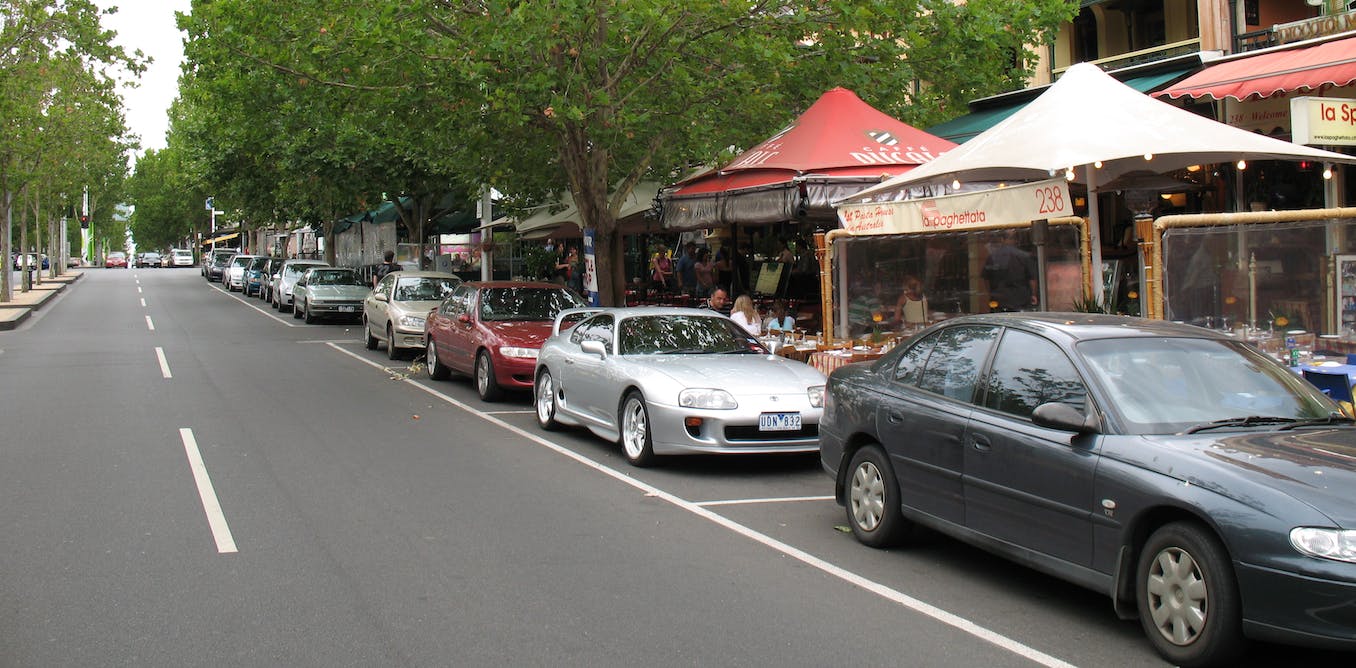Closed streets = street seating and walkable communities. Who’d expect those advantages to get people to stop for dinner when walking by.
The mark up on drinks, especially alcohol is where a lot of profit is. If people don’t need to drive, they probably drink more too.
When restaurants complain about a lack of parking, they really mean a lack of access. Make them accessible and they’re happy.
A lot of previous footpaths and parking spots have been repurposed as dining areas here in Sydney. I don’t think the restaurants are complaining about that and it adds vibrancy to the area that makes them more attractive too.
When restaurants complain about a lack of parking, they really mean a lack of access
The real problem is that they grossly overestimate how much of their patronage comes via driving currently. So they actively fight against improved access in the form of things like bus lanes, light rail, and bike paths.
The data says that restaurant owners think over half their patrons currently drive, but that in reality it’s less than one in five.
There was a similar article about store owners last year (or maybe early this year) that said they make the same mistake. That was specifically done in the context of the installation of some fairly mediocre bike paths in the Brisbane CBD (the “CityLink Cycleway”). Many had petitioned against the cycleway at first because of their misunderstanding.
Educating business owners, or disregarding their feedback entirely when they’re stubbornly arguing against their own best interest, is the direction we need to be moving in.
The owners also think that people who drive spend more per person than those who walk or take public transit, but the reality is reversed.
If I’m reading the data right, they actually thought public transport users spent the most per person (they thought they were 15% of customers but made up 19% of revenue, or 1.27% of revenue per percent of customers, versus cars which had 1.13% rppc), but their gross underestimate of public transport patronage meant an underestimate of overall revenue despite this.
For fun, the rppc stats in reality were:
- Cars: 1.05
- Walking: 1.09
- Bikes: 0.57
- Public transport: 1.00
Which is interesting, because it does differ from what other studies have said, which is that cyclists and public transportation users tend to spend more than drivers, where in this study they spent less per person. I wonder how quality of infrastructure and service would impact that. Pedestrians still spent the most per person, though.
Ah, I found the CityLink Cycleway feedback source. It wasn’t an article, it was mentioned in a Brisbane City Council meeting YouTube link with timestamp (roughly 1:32:00). Businesses on the relevant streets in the Brisbane CBD estimated 43% of their customers arrived by car, when it was actually only 19%.
Council meeting minutes (warning, Microsoft Office Online link) has slightly different figures of 44% and 19%, respectively.
Incidentally, then-Councillor Sriranganathan’s speech immediately after Cr Murphy shares his figures gives a pretty good explanation of some of the reasons I described the CityLink Cycleway as “mediocre”.
mk4 supra 👍
“In this case, Eagle Street scored highly. This was mainly due to it having the highest parking fee (A$30-$75 for three hours) of the three restaurant precincts. Even in Caxton Street, which has the cheapest parking ($11 for three hours), more than one in three customers travelled by public transport.”
Also, water is wet.
Lovely unbiased article
That was really interesting - thanks for sharing!
What? No mention of Ubereats, Doordash or the like? You’d think parking is damn important for them…
@No1 @Zagorath Especially in inner-city areas, many of those deliveries are done by bike.
And because most suburbs lack proper Dutch-style protected bike lanes, those riders either have to try to avoid getting hit by cars if they cycle on the road, or dodge pedestrians on the footpath.
Fewer parking spots and more protected bike lanes would help, rather than hinder, many food deliveries.
Tru dat. And the article was really about inner city. I was still surprised that there wasn’t any mention of the delivery services at all. They should include your comment in their article!
Out in the 'burbs, though, drivers won’t pickup from some restaurants/etc because it’s too hard or takes too long to find somewhere to park…
I fucking hate the complete lack of parking anywhere that doesnt cost an arm and a leg. Not to mention car parks are getting smaller. Thry claim its to help discorage car usage to help global warming but in reality its just greedy fuckers.
The reason cities are so spread out is because roads and parking lower density. It’s the solution to its own problem.
We cannot continue car dependency if we want to continue existing and restructuring our cities to suit other modes of transportation will take a lot of time and effort. There will be growing pains but I think success stories like Norway show it is possible.
Just walk you lazy fuck.
…said someone who lives less than an hour’s walk away from anything worth walking to
I mean, that’s its own pretty horrible problem with how our city planning works.
This is the real issue. Family living in the inner 'burbs or fringe is either impossible or just way out of reach. But then I have to drive a minimum of 45mins to get to the city.
Worse still, I live in the SE and work in the west. I have to drive a minimum of 65km each way for work. And public transport just isn’t an option for what I do, and where I work.
Skill issue. Ride a damn bike.
I just did the maths that will only take me 2hours 3minutes each direction. Ohh and i really think its a good way to earn a darwin award riding a bike on a road with no curb and people going 80km/hr.
Removed by mod
buy a smaller and more efficient car.
A small car takes up just as many parking spaces (i.e., one) as a big car does (i.e., also one). If the problem is parking – and boy howdy, it is! – then the only solution is to show up in a not-car (e.g. riding a bike or on foot), not a small car.
*for certain values of big car.
If the parallel parking is unmarked. I can part my Jimny in half the space of a large sedan or SUV. I can only carry 3 passengers, but all of life is a compromise.
Man, I wish I could have a Jimny.
Anyway, yeah, I know short cars are short. The trouble is that unmarked parallel parking is a tiny fraction of all parking, so the size of cars really doesn’t make much difference in terms of city-wide macro scale. (Unless you went all-in Japan-style and put them in their own separate category with kei-car-only parking spaces and such, anyway.)
First thats fucking expensive. Second i like my car. Third the best thing u can do for the enviroment with a car is buy a second hand one drive it forever. Forth fuck anyone who talks about carbon footprint it was a term invented by bp to pass the blame to the consumer for the enviroment.
And if anyone suggests public transport, yeah thats a great idea i love the concept unfortunatly we dont live in europe and to hell with waiting 40 fucking minutes for a bus when i can drive in 10.
That concludes my rant wasnt directed at u just the state of the system as it stands.
to hell with waiting 40 fucking minutes for a bus when i can drive in 10
I actually agree completely. It’s a serious problem.
But it’s also why we need to be investing more in public transport. We need to take away street parking to make room for bus lanes (or even better—build light rail!) to enable them to run quickly and efficiently. We need public transport that runs on 15 minute headways during non-peak times, up to more like 5 minutes or less during peak. And at least half-hourly even overnight.
We also need to up the density of our housing, and allow for greater mixes of local businesses (mixed-use zoning), so that more trips are shorter and can be easily walked or cycled.
The point is, you’re right that in many cases, our current public transportation options are really bad. But the solution is not to just keep making driving easy. That’s just throwing good money after bad.
Ur 100% correct. Im just complaining that the options for cars are being removes and public transport is stagnet or in some cases activly getting worse.
If your two middle paragraphs are listed in order of priority, they’re backwards. Transit doesn’t work without having density first, so fixing the zoning code should be a higher legislative priority than funding transit.
If your two middle paragraphs are listed in order of priority
They are not. They were merely in the order it came to mind, based on context. Since the thread is primarily about road design, it’s natural that the existence of public transport should come first. That’s also why I started with “bus lanes” first, and not light rail. Bus lanes most directly compete with parking lanes, while light rail tends to compete indirectly (bus lanes literally being located in what would otherwise be parking space, while light rail tends to run down the centre but possibly requiring removal of parking to enable car lanes to continue to exist).
That said, I reject the notion that it needs to be done in a particular order. That’s a surefire way to ensure nothing ever gets done, because you might say you need density for improved public transportation, but someone else will say they won’t get rid of their car until there is first good alternatives.
But also, while higher density is certainly necessary for cyclability, I don’t even believe it really is that necessary for public transportation to be viable. Remote US towns were built on the backbone of train networks. Rural towns in Europe have better public transport than much larger cities in America. Yes, increased density makes public transportation even more efficient, but efficiency is not a necessity for it to be viable. Only the political will to have it be good is necessary.
So I support, very strongly, any effort to improve public transport or increase density, regardless of whether it is done before, after, or alongside the other.
You know what? You’re entirely correct.
I love it when people like you get angry at my cities anti car policies. It’s nice to know the assholes are seething
By being anti car it indicates the critical failure of design. You dont want to force people away from cars u want to make public transport a better more appealing alternative.
You dont want to force people away from cars u want to make public transport a better more appealing alternative.
It depends what you mean by “force.” It isn’t necessary to legislatively outlaw cars or anything like that, but you really do have to at least stop catering to cars if you ever want public transit to be good. More concretely, you have to change the zoning code to stop limiting density and forcing developers to build parking. That accomplishes two things: it allows there to be enough trip origins/destinations within walking distance of stations to make the transit viable, and it limits the available parking to only that which the free market is willing to provide (a lot less than zoning codes typically mandate now) which discourages driving by making it hard to find a place to park.
That’s not actually “forcing” anything in reality, but a lot of car-brained people will tend to think it is because to people accustomed to privilege, equality feels like oppression.
(Another related example: NIMBYs think “abolish single-family zoning” means “prohibit building single-family houses,” but it actually means “give property owners the freedom to build either single-family houses or multifamily buildings if they want.” It’s actually deregulation, but the people wedded to the highly-regulated status-quo will swear up and down that the proposed change is some kind of big-government communist plot.)
The fact that people are still trying to drive Dodge RAMs in undercover carparks and down city laneways suggests that failure of design is not the key issue. Fuckwits are the issue.
Designing city’s that encourage social transit over independent transport is one thing. Legislation to prevent people being selfish fuckwits and driving a “Light” Truck into your office job.
As long as its safe why should the government have any say whatsoever over what vehicle u drive?
The argument is that its unsafe to drive a light truck unless absolutely necessary (necessity doesn’t make it safer obviously). The best way to discourage their use would be strict licensing requirements (treat them like medium trucks: 0.0 alcohol) and require they do not enter truck-restricted zones
Yeah yeah yeah, meanwhile my street is much nicer without cars in it, and the shops are full of locals buying things. How sad that you car folks need to stay in your own neighborhoods instead of giving us all brain damage.
You dont want to force people away from cars u want to make public transport a better more appealing alternative
It really depends on what you mean by “force”. Certainly we don’t want to just ban cars, but in order to make public and active transport appealing, some restrictions on driving are necessary.
For example, at the moment you can drive from anywhere, to anywhere, via almost any route. This makes even local streets unnecessarily dangerous because people end up driving through unrelated local streets when that ends up being faster than sticking to main roads. Which in itself is making walking and cycling more dangerous, causing more people to drive instead.
If instead we used modal filters—sections of local streets that you can’t drive through but can walk or ride through—that would definitely make driving seem “worse” because rat running would no longer be possible and access to local streets would be possible only via one route instead of 4 different ones, but it would also make walking and cycling better, too. It would make them safer, and would mean for some trips they can literally take a shorter journey.
This is just one example of good design. There are a number of other ways things can be designed better that might both help public and active transport users and hinder car use. Ironically, if done well, even all this would actually make driving better, because the number one problem for drivers at the moment is other drivers. And if you design well, you can reduce the number of other drivers, so anyone who continues to drive will have a better experience.
It’s not about “forcing” anything. But it is about incentivising and disincentivising things to arrive at a better overall transport network.
And why does someone else’s misery make you happier?
Removed by mod
Depends a lot on the car.
Keeping a HSV Avalanche on the road as your primary vehicle so that you do not have to buy a newer car is probably not a fiscally or environmentally responsible choice. Nor is replacing it with a Rivian or Lightning.
Maybe a Suzuki Swift or a Nissan Leaf would be a better choice.
Alright using your examples which seem awfully chery picked the break even point of co2 in terms of years being as generouse to the suzuki as possible is about 4.16 years. Depending on age the average time someone keeps a car is 6-10 years (older people tending to keep it longer) that means about half the lifespan of ur suzuki must be spent before u break even on carbon cost. If u do the same calculation for electric vehicles u find they have a far longer break even period.
If u do the same calculations for my car it will take 27years to break even in terms of carbon cost.
What do you mean break-even point? A petrol car will emit CO2 to produce and drive, an electric one charged exclusively on renewables will only require CO2 to produce (which I assume will be phased out at some point). I am quite interested in these calculations
The production and recycping/disposal co2 costs are much heigher than u would expect. U cant get around these u cen reduce them but there are proccesses where u can not avoid pumping greenhouse gasses into the atmosphere (these can be handled by the enviroment if we hadnt been making more than nessasary for so long). And electric cars are very rarely charged exclusivly on renewables and even if they are u need to account for the carbon cost for the lifecycle of those renewables as well. U also need to account for energy losses cos thermodynamics is a bitch etc etc.
How i did calcs: Talking specificly about the case i was arguing for before where u already have a car. U can get estimates of co2/kg for producion and recycling of a car. Using that and the cars weight get its production and disposal costs. U have already “paid” the carbon cost of manufacture for the car u already own so u only have the operation. But if u where to buy a new car u have both the production of the new one and the disposal of the old one(why reduce reuse recycle is in that order) to account for. Add the yearly cost as ur linear factor. Both can be plotted on a graph and the intersection will be the time period where u break even.
If u also put electric cars on the plot they are actually worse than ur average petrol car (currently with our non renewable grid) cos u have all the losses from energy transformations electric car goes: chemical energy to heat energy to mechanical energy to electrical energy back to chemical energy (ur battery) to electric energy to mechanical energy opposed to a petrol car which goes chemical energy to heat energy to mechanical energy.
An electric car run purly on renewables might have a lower co2 cost but lithium mining is disasterouse for the enviroment. And cobalt mining is power by slavery. Its a fucking disaster all round and at this point the option with the lowest cost to humanity is looking like sacricing millions or poor people to the greater good untill we have enough rare earth minerals to have a proper recycling lifecycle. Its like the early days of aluminium extrordinarily expensive and bad to produce but once produced very easy to recycle.
So what’s the solution then? You said you like your car so I guess we can’t do away with that.
Second i like my car.
Too bad. You are not entitled to impose the costs of your car on the rest of society just because you like it. Pay the whole cost yourself instead of demanding demanding to use public space for your private car storage for free.
Oh shit!
Do car owners not have to pay any kind of tax supporting said public spaces?!?
Where do I go to file for my refund?
Do car owners not have to pay any kind of tax supporting said public spaces?!?
Not in proportion to their fair share!
How much gas tax, or registration tax do you pay to support the roads you are using?
You mean, as a cyclist? $0, and I’m still subsidizing you even at that price!
https://www.cyclingutah.com/advocacy/who-owns-the-roads-anyway/
Its not like im the only person in the world with a godamn car. Why dont we just completly abolish roads while we are at it. I will continue to demand that i can park my car near wherever the fuck i need to go untill it is faster and more convenient for me to take public transport. I used to be able to park i nolonger can and public transport hasnt become viable for me why would i give something up with nothing in return.
Or you could park a little bit further away and walk the remainder of the distance? It’s not difficult.
Neither is leaving a carpark where it is and not selling it to a land developer to make as many dolarydoos as ya can
Unfortunately car parking lots are just not good economics. Most customers don’t drive, so providing an opportunity for more businesses to set up shop, or making more space for people to live (in a housing crisis!) is an extremely good thing. It’s not just about making moolah for the developers, but also about providing the best outcome for all the humans who might use that space.
Likewise, on-street parking in the inner city streets, or outer suburb main roads, is a poor use of space compared to bike paths and bus lanes. (Nobody is suggesting getting rid of the ability to park on the street in local residential streets in the suburbs.)












